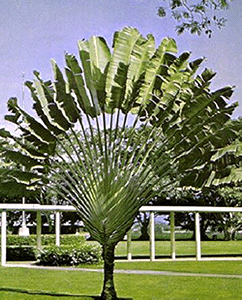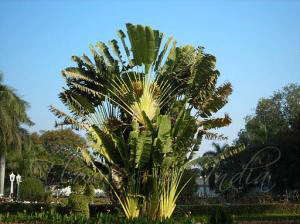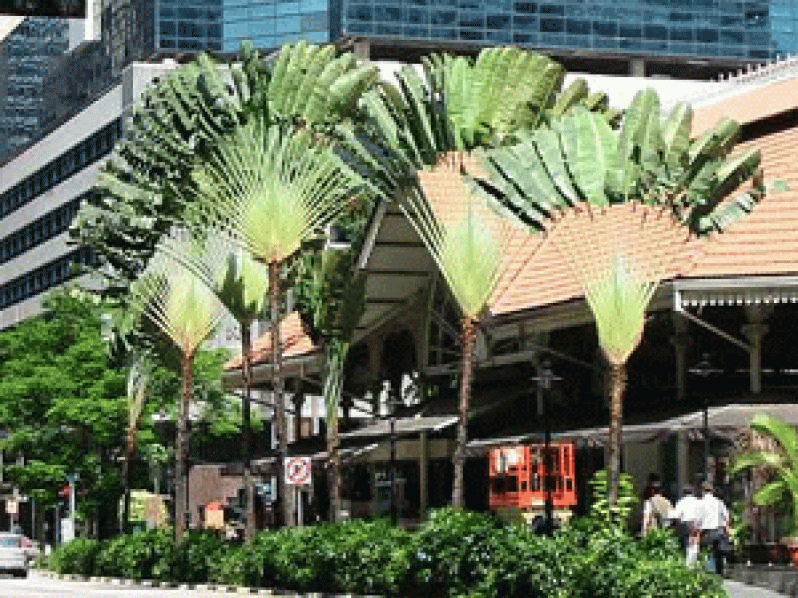Ravenala madagascariensis: The ‘Mother Hen’ of flora
THE unique Traveller’s Palm, or Ravenala madagascariensis, is one of nature’s most distinctive and remarkable plants; and it is grown locally.  Monotypic, meaning it is the only species in its genus, the name madagascariensis denotes its origin in Madagascar, an island country located in the Indian Ocean off the southeastern coast of Africa.
Monotypic, meaning it is the only species in its genus, the name madagascariensis denotes its origin in Madagascar, an island country located in the Indian Ocean off the southeastern coast of Africa.
Ravenala grows up to 40 feet tall, while the enormous banana-like, paddle-shaped leaves, borne on long stalks in a distinctive fan shape aligned in a single plane, can grow up to 15 feet long, giving the tree the aspect of a hand fan.
The colour of the leaf stems varies from orange at their base to yellow in the middle and to bright green closer to the end. High winds can shred the leaves, giving them a feather-like appearance.
In its native Madagascar, the plant is given the name ‘Traveller’s Palm’ because the sheaths of the stems store rainwater, which can be used as an emergency drinking supply, especially for the traveller during a drought, and also because the fan tends to grow in an east-west line, providing a crude compass of sorts.
It is also said that “if a traveller stands directly in front of a Traveller’s Palm and makes a wish in good spirit, that wish will definitely come true.”
Ravenala madagascariensis grows in noticeable abundance in neighbouring Suriname. The palm has been described as perfect for a special accent in a tropical landscape. Although it has no thorns, the palm is known for snagging the attention of many an onlooker. It is the main attraction and focus of any landscape in which it appears!
In Guyana, the palm is used as a shade provider to be planted to the south or west of the house. If space is left in your yard, try planting three or five of these palms next to each other. This provides a perfect screen, and still leaves space at the bottom for some colourful groundcover or other ornamental plants.
To assist in accelerating the growth of the Travellers Palm in our heavy clay soil, dig a hole three feet deep and three feet wide; mix  the excavated earth with 1/3 sand and 1/3 mulch. The Traveller’s Palm is extremely resistant to fungi and pests, and has a lifespan of between ten and fifteen years.
the excavated earth with 1/3 sand and 1/3 mulch. The Traveller’s Palm is extremely resistant to fungi and pests, and has a lifespan of between ten and fifteen years.
After some years, the Traveller’s Palm develops young ones, or “chickens”, which grow close to the main trunk. Attempting to excavate the “chickens” can be very tedious, and they have a survival rate of only about 50 per cent. It is advisable to cut out the young shoots as soon as they emerge, and use them as compost. When the “chickens” are not removed, the situation evolves into a micro jungle.
The lower, drier leaves must also be removed, but not with a cutlass; a hacksaw blade ideally leaves a clean and attractive stem.
The Traveller’s Palm is just another one of the wide range of plants cultivated and available for sale at the #1 Plant Shop on Sheriff Street (Tel # 227 8094). Staff members there are willing to provide technical information on how this unique plant can be successfully cultivated for gardening and/or landscaping purposes for your yard.
In the ‘green’ corner…
SHARE THIS ARTICLE :
Facebook
Twitter
WhatsApp



.jpg)









